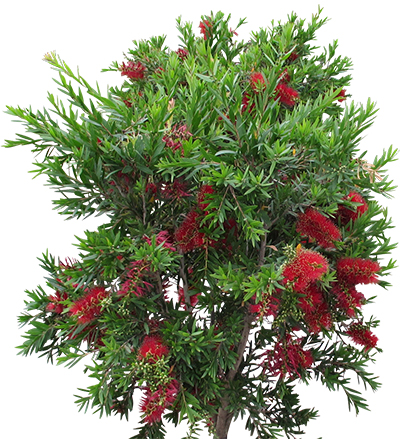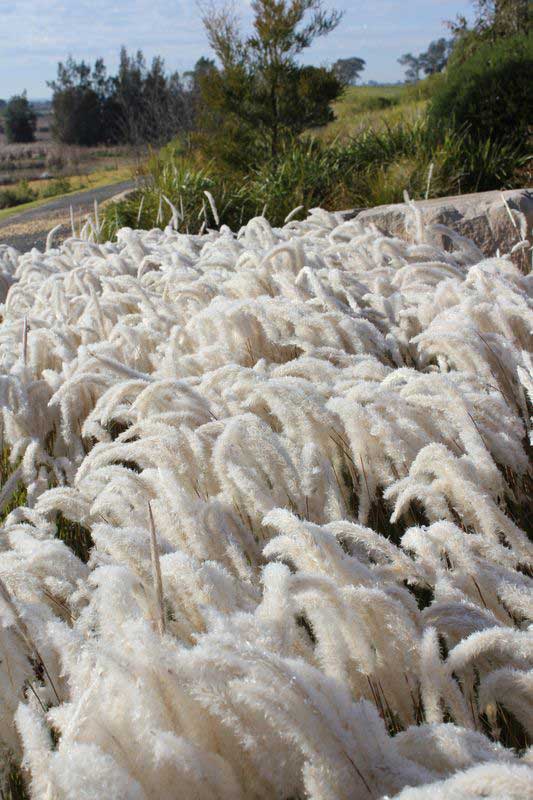Are you wondering, “what are the best plants for a rain garden in Australia?” You’re not alone.
As we face the challenges of climate change, the concept of rain gardens has become increasingly important in sustainable landscaping. Rain gardens, with their ability to manage stormwater runoff and enhance biodiversity, are a fantastic addition to any landscape.
However, the usual plant palette often leaves much to be desired, with the same monotonous reedy plants like Carex, Juncus, Cyperus, and Phragmites being specified repeatedly. When our choices resemble weeds, it’s no surprise that some residents view bioswales with disdain.
But it doesn’t have to be this way. Exciting plants such as callistemons, agapanthus, and westringia can thrive in these conditions too. But before we delve into the best rain garden plants, let’s understand why they work when others don’t.
We’ve tested a lot of plants for wet feet conditions. Some thrived, and others did not. The Callistemon showed here is. Macarthur™ Callistemon viminalis ‘LC01’ PBR.
Understanding the Conditions in a Rain Garden
Rain gardens and bioswales are unique habitats designed to mimic natural waterways, slowing down and cleaning stormwater runoff. They play a vital role in the urban landscape, but their conditions can be challenging for many plants. Rain gardens are subjected to variable temperatures, fluctuating moisture levels, specific soil types, and varying degrees of sun exposure.
Climate
Australia’s vastness means climates can vary dramatically from one region to another. When selecting plants for your rain garden, it’s vital to choose species well-adapted to your local climate. Rain gardens also create unique microclimates, with conditions differing from the rest of your garden due to their design and function.
Moisture Levels
One of the defining characteristics of a rain garden is its fluctuating moisture levels. They’re designed to temporarily hold and slowly drain stormwater, meaning plants must withstand periods of both flooding and drought. This dual requirement can limit the plant species that can thrive in both extremes.
Soil Conditions
The soil in a rain garden is not your average garden soil. It’s better if it can drain quickly, yet hold enough moisture to support plant life during dry periods. However, even in the worst of soils, you can find a plant that can tolerate conditions. Keep reading to learn which plants.
Planting Zone Depth
Next, consider the planting zone depth. Different parts of your rain garden will retain water differently. For instance, the bottom of the garden, often referred to as the ponding area, will hold more water than the edges. This variable moisture gradient means that different plants are suited to different parts of the garden.
Plants like westringia (Westringia fruticosa), with their preference for well-drained soil, would do better along the edges or higher sections of the garden. In contrast, species that can tolerate more water, such as various sedges (Carex spp.), could be positioned in the lower, wetter parts of the garden.
Don’t worry, we’re going to discuss Carex alternatives soon… and even a couple of westringias that can sit at the bottom of depressed areas.
Sun Exposure
Sun exposure in a rain garden can vary significantly, depending on its design and location. Some parts may receive full sun, while others might be partially shaded. I know this is obvious, but understanding these microclimates will help inform your plant selection, ensuring each plant is suited to its position within the garden.
Maintenance Requirements
Lastly, consider the maintenance requirements of your chosen plants. Given the variable conditions within a rain garden, it’s generally best to opt for low-maintenance plants. These plants will not only make your life easier but also contribute to the sustainability of your garden.
Low-maintenance plants are typically those that are well-adapted to local conditions and can thrive with minimal intervention. They should be resistant to common pests and diseases and require little to no additional watering or fertilising once established. This not only saves time and resources but also supports a healthier ecosystem within your garden.
Low maintenance can also relate to the amount of pruning required. Basically, a low maintenance plant is one that you don’t have to babysit.
Yalba™ Imperata cylindrica has incredible plumes, and its seeds aren’t weedy, but its rhizomes will take over if not controlled.
Best Rain Garden Plants in Australia
Sure, you could opt for the same old reedy plants that everybody uses. Or, you could choose more exciting plants that will not only thrive in the unique conditions of your rain garden but also add a touch of beauty and interest.
At Ozbreed, we’ve extensively tested our range of “buffer plants” that are perfect for rain gardens. These plants can thrive in extended wet and dry conditions, making them ideal candidates. They’re functional, low fuss, low maintenance, and certainly more exciting than the usual suspects.
Here is a list of some of the best plants for rain gardens in Australia:
- Slim™ Callistemon viminalis ‘CV01’ PBR
- Macarthur™ Callistemon viminalis ‘LC01’ PBR
- Better John™ Callistemon viminalis ‘LJ1’ PBR
- Green John™ Callistemon viminalis ‘LJ23’ PBR
- Yalba™ Imperata cylindrica
- Isabella® Liriope muscari ‘LIRF’ PBR
- Just Right® Liriope muscari ‘LIRJ’ PBR
- Amethyst™ Liriope muscari ‘LIRTP’ PBR
- Katie Belles™ Lomandra hystrix ‘LHBYF’ PBR
- Lucky Stripe™ Lomandra hystrix ‘LMV200’ PBR
- Shara™ Lomandra fluviatilis ‘ABU7’ PBR
- Evergreen Baby™ Lomandra labill ‘LM600’ PBR
- Tropic Cascade™ Lomandra hystrix ‘LHWP’ PBR
- Cosmic Pink™ Rhaphiolepis indica ‘RAPH02’ PBR
- Cosmic White™ Rhaphiolepis indica ‘RAPH01’ PBR
- Grey Box™ Westringia fruticosa ‘WES04’ PBR
- Mundi™ Westringia fruticosa ‘WES05’ PBR
- Nafray® Pennisetum alopecuroides
This is one of the only westringias that can thrive in both flooding and drought. Grey Box™ Westringia fruticosa ‘WES04’ PBR.

Conclusion
Rain gardens are unique habitats that provide an opportunity to create a sustainable, beautiful, and functional landscape. The conditions in rain gardens—variable moisture levels, climate considerations, specific soil types, and sun exposure—can be challenging, but with the right plant selection, these gardens can thrive.
Choosing the right plants involves considering their water tolerance, suitability for different planting zones, and maintenance requirements. Fortunately, there are many exciting options available that are well-suited to these conditions, as demonstrated by our list of top plants for rain gardens in Australia.
In conclusion, rain gardens are not only a solution to managing stormwater runoff and contributing to biodiversity, but they also present an opportunity to showcase exciting, resilient plants. By considering the unique conditions and carefully selecting plants, you can create a rain garden that is both functional and beautiful—a testament to the power of sustainable landscaping.


